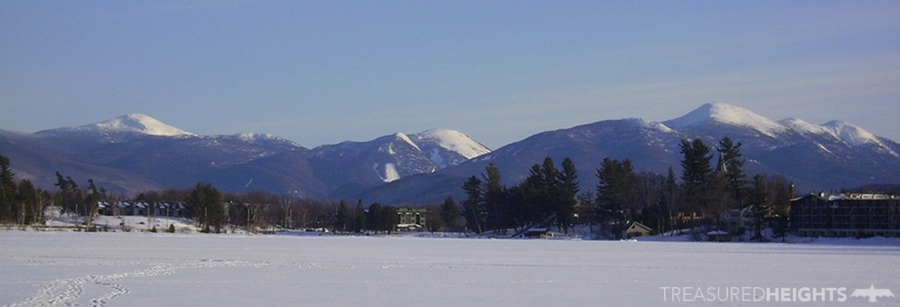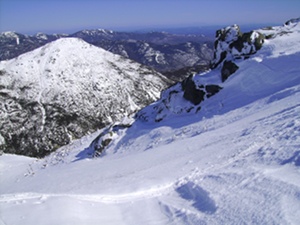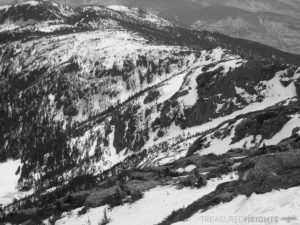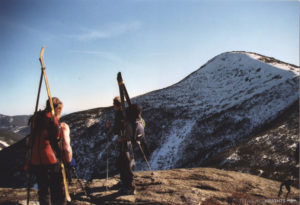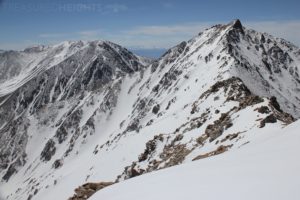The Adirondack Mountains of northern New York State give a true wilderness skiing experience.
Six million snowy acres of public lands in the Adirondacks create a great place for all types of skiing. The highest peaks offer 3000+ vertical feet of everything from steep tree’d powder lines to open alpine vistas above treeline. All this terrain is put in a setting more wild than almost any other state along the East Coast.
SECTIONS:
- A High Bar to Ski Here – do you have what it takes?
- Sweet Open Terrain – slides, alpine terrain and avy info
- The Scale and character of the Adirondacks – about the snow, climate and size
- Skiers and Regulations – Stuff you should know
- Skiing History in the Adirondacks – how did we get where we are?
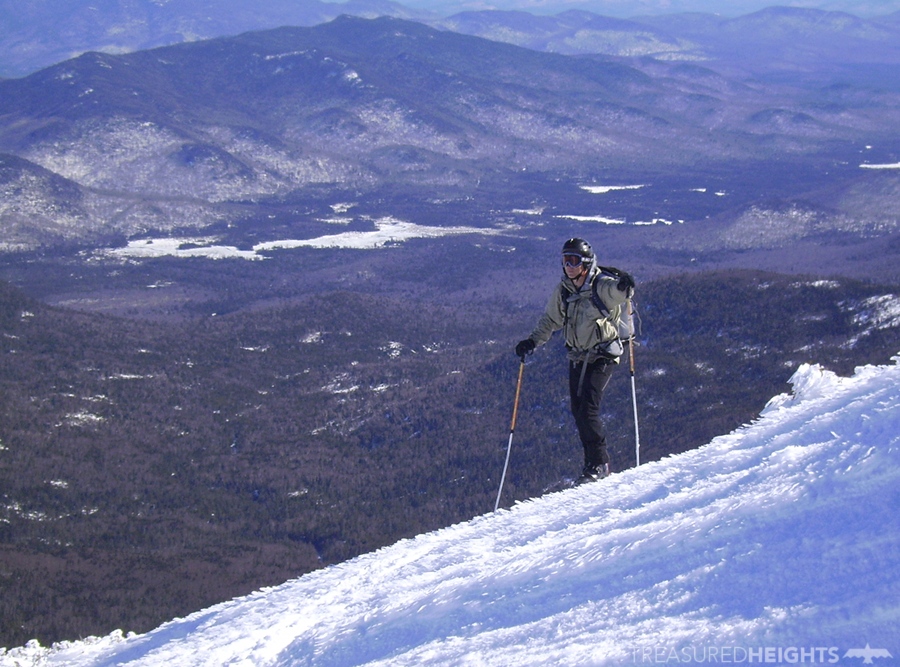
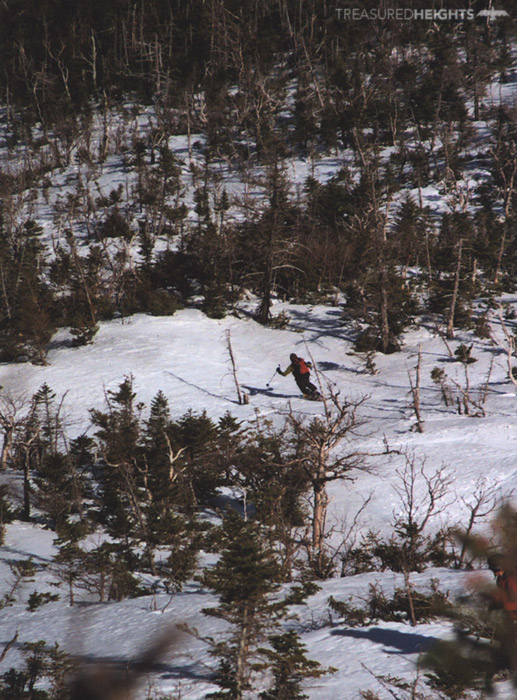
Less skiers in the Adirondacks compared with New Hampshire and Vermont:
We’ve seen a boom in backcountry skiing in the United States over the last 15 years. Most of the newcomers I’ve seen nationally are seeking moderate open terrain, safe from avalanches and easy to get at. There is no place that fits this description perfectly in the Adirondacks. You won’t find anything like Berthoud or Rogers Pass here. The “Dacks” are the playground of those who’ve already mastered in-bounds woods and steep icy trails, with the exception of the uphill ski crowd at Whiteface Mountain. Local Adirondack backcountry skiers love their wild playground and have epic tales of powder, steeps and solitude.
A high bar set to ski or splitboard here:
Do you have what it takes?
While the Adirondacks are friendly for touring, they have a high bar set for peak skiing. I really respect the early “modern” backcountry skiers of the 70s and 80s here who sported long non-release telemark skis in this terrain. It took incredible skill to complete descents. The forests in the higher peaks are really dense and unforgiving. If you find glade skiing at resorts challenging than you’ll end up taking a long time picking your way through actual wild forests up here, master your trees before trying peaks here.

Narrow trails:
Most trails in the ‘Dacks are designed for hikers at only 3-6 feet wide. There are “ski trails” here on Wright Peak, Mount Marcy and a few others, however these are still “narrow” by most resort skier’s perspectives at 5 – 20’ wide. Early backcountry skiers from the “modern age” (post 70s) used to target streambeds as lines. Early skiers like Ron Konowitz used streambeds in order to send all of 46 high peaks between the 70s and 90s. No matter how and what you ski though you will need to deal with narrow trails at some point in the journey.
Please take this warning seriously about narrow trails and think twice about dragging your friend who’s on the fence. If you haven’t mastered narrow tree skiing on resorts, you shouldn’t be here. Accidents involving trees can happen to anyone, reduce your chances by waiting until you’ve had enough experience in a ski-patrol served area. Whiteface Mountain and it’s patrolled sidecountry is a great place to practice.
January 14, 2018 – Snowboarder rescue requiring helicopter on Mt. Marcy. Adirondack Explorer>
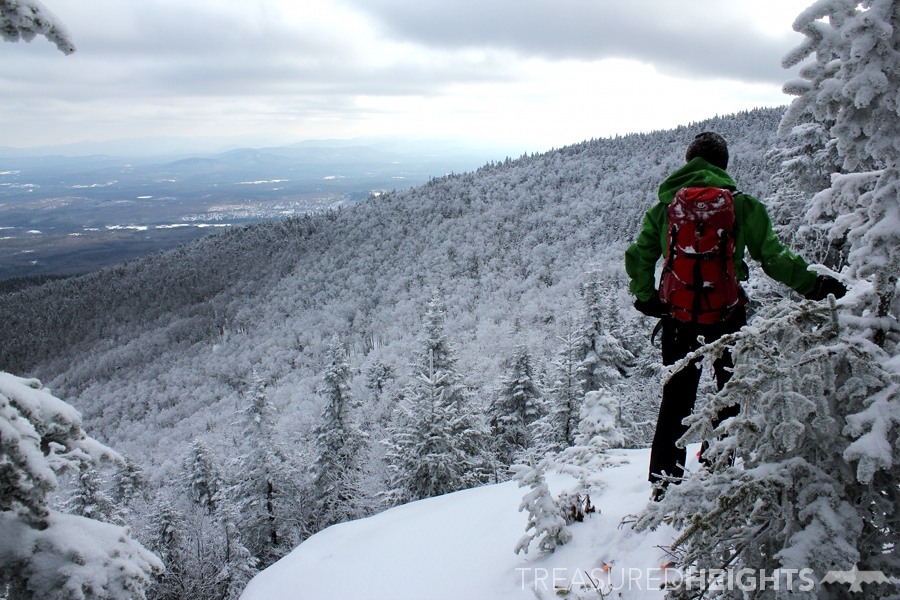
The ice:
They don’t call it the Ice Coast for nothing. with anywhere in the Northeast it’s important to respect and be able to deal with ice. Many steep lines turn into near-vertical hocky rinks of bumpy iron-hard ice during times with bad conditions. Icy chokes must be dealt with at times on trails and slides, and the type of ice is super dense.
- Bring crampons, above treeline can be glaze ice, below treeline can have small ice waterfalls as part of the trail
- Slides have steep sections and will kill you irregardless of your skiing and boarding ability. Many famous pro skiers and boarders have died from either waterfall ice, glacial ice or that white deceptive sh-t that looks like snow from a distance. The white ice that resembles teflon-covered concrete can cause a slide-for-life at just a 15 degree angle, so even the most tame Adirondack slide routes can be deadly after East Coast ice storms.
- Ice climbing experience is very helpful. Know how to set up anchors with screws if you end up trapped on steep icy terrain. Ice climbing also teaches you to respect and recognize different types of ice on your planned route.
Video excerpt: YouTuber “Anthony” dealing with the steep powder on ice at the end of Kilborn slide. This was in “great” conditions, most of the time ice waterfall on slides are unskiable and you have to ski or walk around bulges.
Be prepared to rappel or crampon down the nasty bits. Side slipping or stepping down dense waterfall ice is a really bad idea. In the video above he had dense snow bonded to the ice, don’t expect similar conditions. Ice can be a great sliding surface for avalanches.
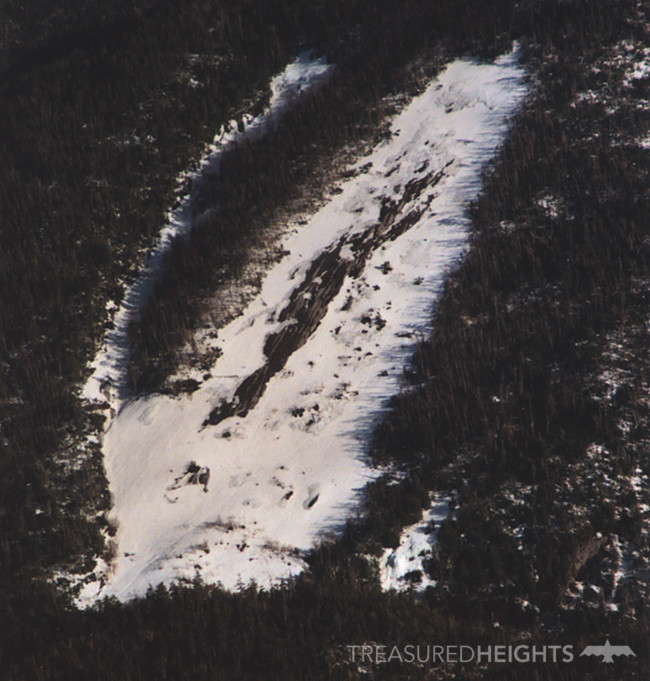
The sweet open terrain
The smooth granite block-domes that form these peaks make it easy for landslides to strip away vegetation and soil. Locals call these formations “slides” and they can have some of the greatest skiing in the Northeast. These lines can be over 2000′ of powder leading right down from treeline. Slides can be easy at 20 degrees – inviting for beginners, and they also can be steep. Some slides turn into waterfall ice and massive cliffs, other slides are at the perfect angle to cause avalanches (be careful with the Angle Slides).
Video: a little bit of alpine terrain on Algonquin. It’s a long video but I just wanted to highlight the cool run shown from 4:35 where it starts when you hit play. Video by Jesse Williams.
Avalanche issues:
Vinny McClelland told me about some of the avalanche history here. He is a long time Adirondack backcountry skier and owner of the Mountaineer, he founded the store in the early 70s in Keene Valley. The Mountaineer is the focal point for backcountry ski culture in the region and they hold events and festivals which bring in top names like Glen Plake and Conrad Anker. He said that it is really hard to do useful avy forecasting for the slides here as each area has unique conditions. Slides range from 10’ to 500’ wide and face all aspects. Trees on narrow slides block winds or direct sun, while wide open slides allow winds to remove all snow down to the waterfall ice that coats the granite. Two slides on the same aspect of a mountain can be completely different. Despite this difficulty in forecasts there are times when New York State’s Department of Environmental Conservation has issued general widespread avalanche warnings. The Mountaineer hosts classes of different types on Avalanche Education.
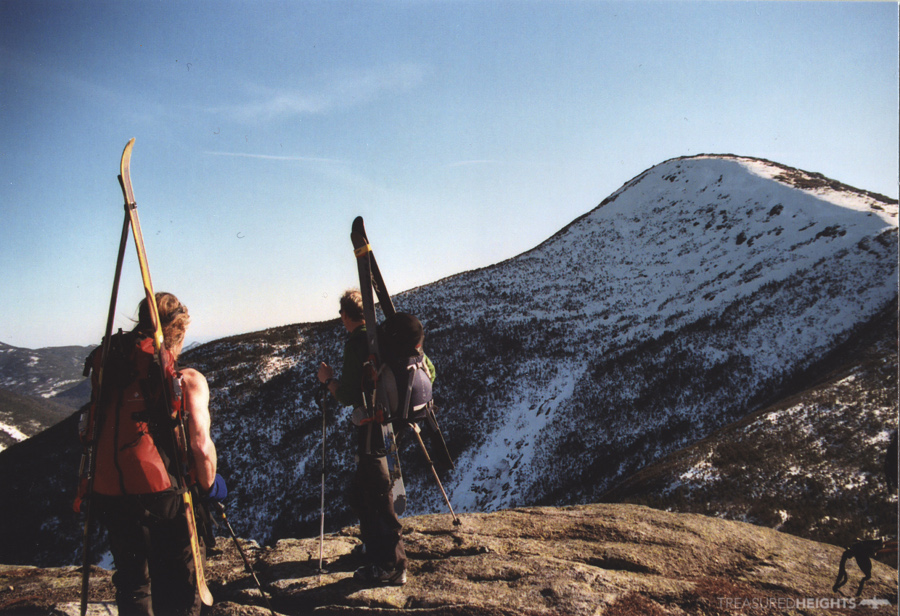
Long approaches and the right conditions:
Slides are an obvious target for backcountry skiers today when conditions are good. Much of the year slides can be nothing but waterfall ice bulges with loose avy-prone powder or windslab sitting on top. Almost every slide in the Adirondacks has been skied. They were skied after locals had waited months or years for the ideal conditions. Given that almost all mountains in the Adirondacks have a long approach it is a risk to do all the work and find out that the target line may not be ready yet. The long approaches contribute to most Northeastern backcountry users hitting places like Mt Mansfield or Tuckerman Ravine instead of the Adirondacks. These other spots have direct road access to the base of the mountain.
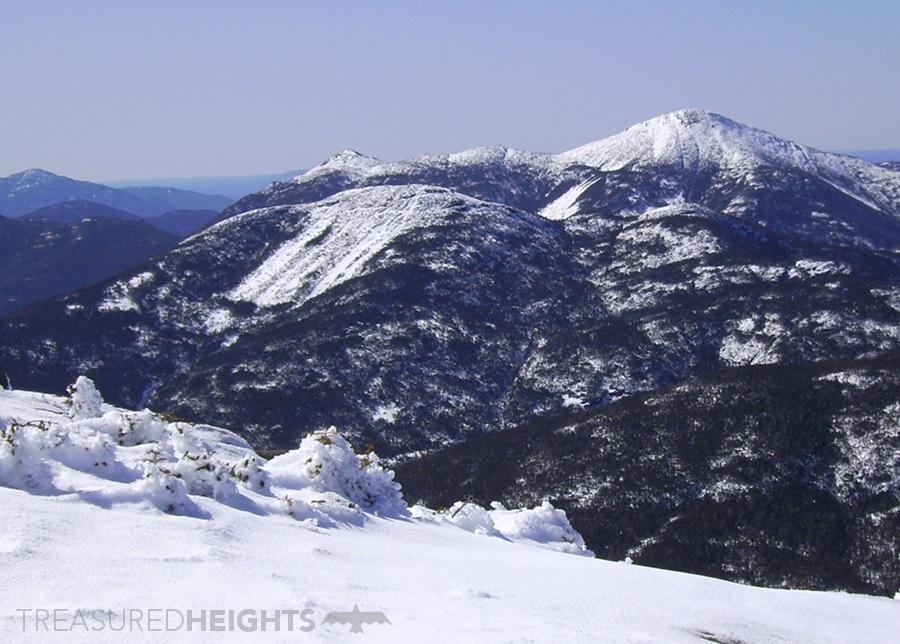
The scale of the Adirondacks:
The Adirondacks are more wild than the Green and White Mountains of Vermont and New Hampshire, and this means you can expect long approaches. It is not uncommon to spend 2 or 5 miles on the approach before you even begin climbing a peak. Mount Marcy, the highest point in New York State is about 8 miles from the nearest trailhead. Summit to trailhead vertical averages 2000-3000 feet in the High Peaks region. At Lake George, Indian Lake and other peak clusters you can get a good one to two thousand vert.
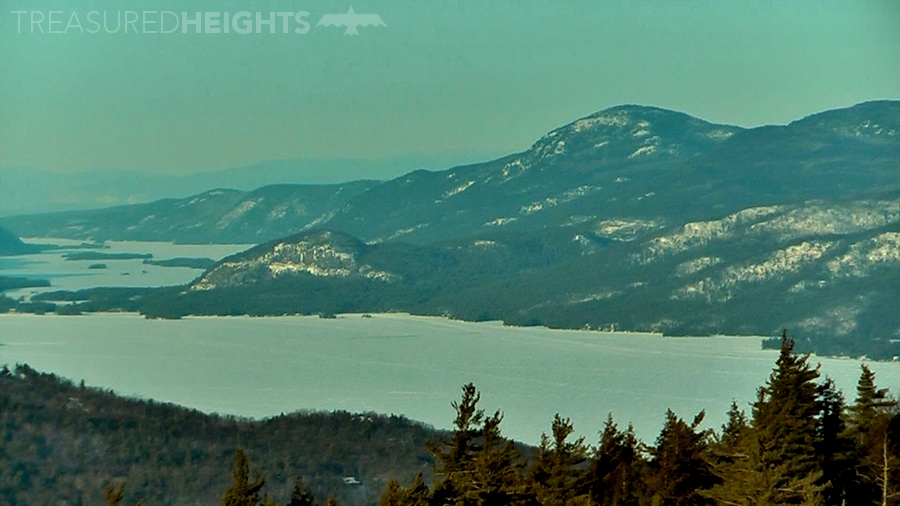
The vegetation of the Adirondacks is similar to the White and Green Mountains of the Northeast with thick spruce-filled krummholz above 3500’. In the Adirondacks tree line is roughly 4800’ and there are about 85 acres of alpine tundra. About 17 peaks have significant terrain above treeline, or heavy scarring that lowers treeline and gives the ski an open feel for at least part of it.
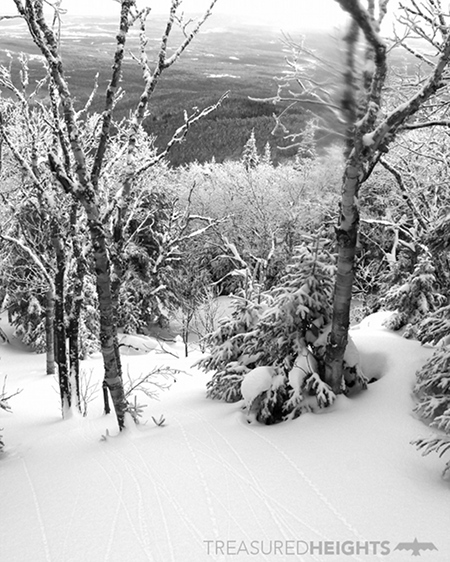
Snow, climate change and Adirondack backcountry skiing:
Vinny McClelland told us how things have changed since he first started skiing peaks here in the 1970s. Since trees are thick here it was natural to ski on streambeds which get frozen over and covered by 4-8’ of snowpack. Since the 1970s streambeds have not been freezing as early, and they melt out sooner. He also said how in the past backcountry skiing season would last into late April, and today it can be all done by March if it is bad year. Check forums to see how conditions are. The Adirondacks don’t get as much snow as the Green Mountains which can get lake effect off of Lake Champlain, however they still usually get a solid 200” at higher elevations. In mid winter on normal years snowpack is usually 1-2’ deep at 2000’ trailheads, and over 6’ above 4500’.
Skiing Mount Marcy in late April >
Treasured heights:
The Adirondack Park is a great example of how to properly protect wild lands, for the most part. The park was formed in 1885 and the mountains have mostly recovered from their rough treatment prior to protection. Unlike National Forests the Adirondack Park strictly protects the state land parcels as “forever wild” so they cannot be leased out to private interests.
Skiers & Regulations:
The New York Department of Environmental Conservation manages the Adirondack park.
- As mentioned before don’t ski on Avalanche Pass Slide the trail below is always busy and an avalanche into that terrain trap is likely to kill others, burying them under at least 3 meters of debris.
- If snow is over 8″ deep you MUST carry snowshoes or have skis. No postholing. It’s actually a regulation here.
- No trimming trees
- No dogs on Adirondack Mountain Reserve lands, this AMR land is not state land and includes approaches to a lot of high peaks. Details here. For the rest of the wilderness there is a leash law.
New York State Forest Rangers are more cops than naturalists and they will give tickets. They are not “chill” like a lot of BLM or National Forest staff. They deal with meth dealers, fugitives and armed anti-government nut jobs in the woods, so they don’t placate to hikers trying to bend rules. Some are real hard-asses and have harassed backcountry skiers with dogs off leash, don’t mess with the rangers.
Bad “new” state regulations for skiers and ski trails:

While early 1900s skiers were some of the greatest advocates for expanded conservation in the Adirondacks, modern regulators seem to forget this. In 1973 regulators revamped park rules and failed to create skier-specific designations for existing ski trails.
The new generation of regulators also defined how wide each classification of trail can be. They labelled the historic Mount Marcy ski trail as a “hiking trail”, and this made it illegal to maintain the ski trail to its proper width. Many ski trails were affected, including existing ski trails on private parcels that the state would buy in the future. These actions spurred the creation of the Adirondack Powder Skiers Association. They push for the ability to grandfather in historic ski trails and protect glades and other trails on private parcels being bought by the state.
Skiing History in a Nutshell
The Adirondack backcountry scene has gone through phases over the years. In the 1920s Irving Langmuir, John Apperson and other personalities pioneered skiing from the summits. After the 1932 Olympics in Lake Placid, skiing exploded in popularity across the US. Ski trains brought loads of newbies from the south to places like North Creek where people either climbed up, or rode pickup trucks up Gore Mountain.
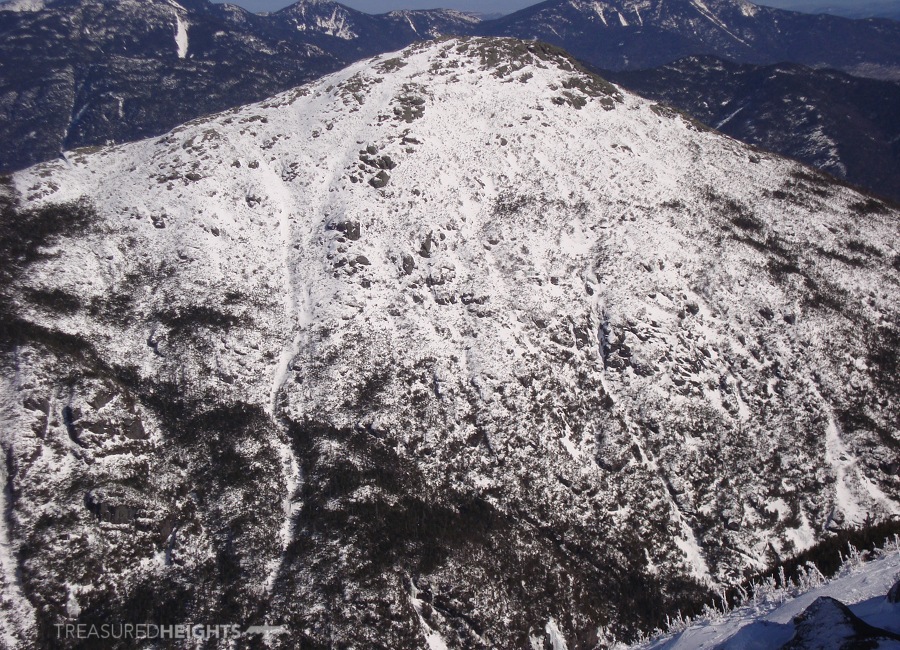
During the 1940s experienced backcountry skiers like Jim Goodwin were entrusted to teach skiing to the 10th Mountain Division troops in Colorado for World War II training efforts. Skiing again went through a national growth phase after the training and war when the troops and brought back the newest equipment and ski technique to their home peaks.
We entered the “modern” age of backcountry skiing in the 1970s and 80s when Ron Konowitz, Mark Meschinelli and others skied the major peaks and steep lines with three-pin telemark gear. The tight-knit group of backcountry skiers of the time continued into the 1990s when I began skiing there. I remember many winter days doing a peak and not seeing anyone the entire day. The Mount Marcy trail did however get a lot of traffic on weekends. You’d see Silveretta bindings and big clunky AT setups sometimes, but most skiers had lighter tele gear. They used wax techniques borrowed from cross-country to make it easy to deal with the long approaches which have plenty of ups and downs.
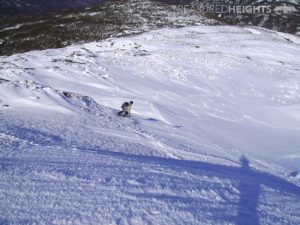
The new age of backcountry skiing in the Adirondacks:
For the last few years the Adirondacks have seen a lot more skiers. According to Lou Dawson by 2015 ski equipment companies were seeing a 12% annual growth in sales of AT backcountry gear. In the Adirondacks numbers have gone up, but not as much as in areas like the Wasatch or Front Range which host easy entry-level terrain. A lot of skiers just do uphilling at Whiteface Mountain which has reliable snow from season start to end. Other people new to backcountry skiing come from the University of Vermont and other colleges. The local High Peaks backcountry ski community grew from about 30 people, to close to 50. Non-locals drive as much 5 hours to come ski here. Despite the growth in alpine touring gear Vinny from the Mountaineer still sees healthy sales in the telemark equipment, an Adirondack tradition.
Former guide and one of the founding members of modern backcountry skiing in the Adirondacks summed up the changes in the last few years:
“The backcountry has changed a lot but in some ways it’s still the same. What is different is the number of skiers and the ease they can access the backcountry because of new equipment. All the classic lines get skied quickly after a storm, so there is more competition now. But the Adirondacks are vast, and if you’re ambitious you can still find great skiing with zero people.” – Mark Meschinelli
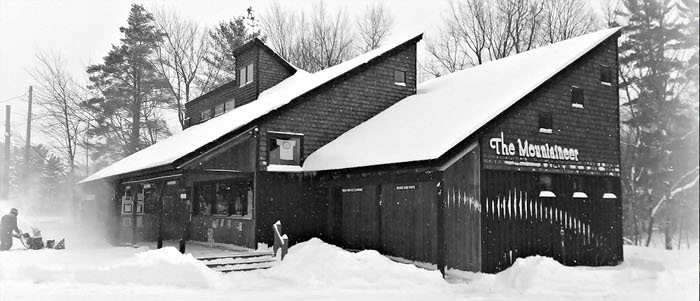
Sources:
Wild Snow by Lou Dawson. 1997
Ron Konowitz – backcountry skier. 2018
Mark Meschinelli – backcountry skier. 2018
Drew Haas – backcountry skier. 2018
Vinny McClelland – backcountry skier. 2018
The Mountaineer website. 2018 https://www.mountaineer.com/
The Adirondack Explorer. https://www.adirondackexplorer.org/outtakes/interview-with-avalanche-survivors
Langmuir’s World by Roger Summerhayes. 1998
Other Articles:
![]() See a weekly stream of photos from Treasured Heights from around the US on Facebook or Instagram.
See a weekly stream of photos from Treasured Heights from around the US on Facebook or Instagram.

